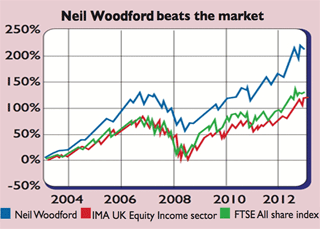
After 25 years, Neil Woodford is leaving investment manager Invesco Perpetual to start his own fund management firm. The news has rocked the British investment world.
In an industry stuffed with mediocrities who overcharge their clients, he stands out as one of the few individuals who delivers outstanding returns on other people’s money, more than justifying his management fees.
Since he began running the Invesco Perpetual High Income Fund 25 years ago, it has returned 2,213%. That compares with 555% for the average UK equity fund, and 1,326% for the FTSE All-Share index.
Although his recent performance has not been as good, he has still beaten the index and most of his rivals over the last decade (see chart). What’s his secret? Actually, there isn’t one. His strategy is mostly common sense – and here are five lessons to take from it.
Stick to your guns
Fund managers make money by attracting more money to their funds. As a result, they obsess over their quarterly (or weekly, or even daily) performance against their benchmark index. This short-termism sees them pursue hot stocks at the expense of long-term returns.
Not Woodford. He famously refused to invest in internet stocks in the late 1990s, sticking to proven long-term businesses. He hugely underperformed the market – indeed, other managers who had the same idea, but lacked Woodford’s track record, lost their jobs.
But by buying cheap, unloved stocks, he boosted his long-term returns and saved his investors a fortune when the internet bubble finally burst.
Make big bets and ignore the index
Woodford is a ‘high conviction’ investor – unafraid to make big bets on individual shares and sectors. At the end of 2012, nearly 25% of his fund was invested in just three pharmaceutical shares – AstraZeneca, GlaxoSmithKline and Roche.
His top ten investments made up 58% of his portfolio, and you won’t find any banks or miners in his fund either.
If you decide to buy an actively managed fund rather than a ‘passive’ index tracker, this is exactly what you want the manager to do – there’s no ‘closet tracking’ here.
It’s also what you should be doing if you pick your own stocks. Yes, it doesn’t always work – you may underperform the market – but if you want to beat the market, your portfolio has to be different from it. Otherwise, just buy a tracker.
Don’t trade too much
One consequence of taking a short-term view is that many managers end up buying and selling lots of shares in a frantic effort to improve their performance. This increases the portfolio turnover rate (PTR) – the amount spent on buying and selling shares as a percentage of the fund’s value.
A high PTR raises costs and lowers returns. Some funds have PTRs of 100% or more. Woodford holds some stocks for years and has consistently kept his PTR below 50% – and so should you.
Dividends matter
You can’t run an income fund without investing in shares paying decent dividends. But rather than just screening the market for high yielders, Woodford understands that future dividend growth is just as important as the current yield. This means focusing on the quality of the business: can it generate enough cash to keep increasing its payouts?
This is probably the reason why Woodford has avoided banks and miners and also why he sold his long-term holding in Tesco.
Low-risk investing can work
We’re always told that risk and returns go hand in hand – you only get higher returns by taking more risk. Yet the fact that for much of the last decade shares have returned roughly the same amounts as government bonds, despite being much more risky, proves this is not always true.
Woodford has proved the same can be true of investing within stock markets too. Dividend investing can be less risky than investing in the stock market as a whole. That’s because you are getting a decent chunk of your return from cash dividends, which – unlike a rising share price – can’t be taken away once paid.
In stock market investing, risk is measured by volatility (how much returns bounce around their long-term average) and is calculated by working out a portfolio’s standard deviation (SD).
In the last decade, the FTSE All-Share has returned 128% with an SD of just over 16%. Woodford has returned 206% with an SD of just over 11%. So not only has he thoroughly beaten the market, he’s also done it by taking less risk – a sign of genuine skill.
Should you stick with Woodford’s funds?
While we can learn a lot from Woodford’s style, his departure highlights a key risk of investing in actively managed funds: what if a star manager leaves?
Identifying a decent manager before they go on a winning run is virtually impossible, and this is essentially what you are forced to do when your star quits. The good news is that Woodford is leaving his funds with a very capable manager – Mark Barnett – who also has a decent record.
Barnett has worked with Woodford for the last 17 years and has a similar approach, so if you own any of Woodford’s funds, I’d be inclined to do nothing yet – although you may want to review things in a couple of years’ time.
It remains to be seen what will happen with Woodford’s management of Edinburgh Investment Trust (LSE: EDIN) – Barnett may end up running this fund too, or it could pass to Woodford’s new fund management company. Hold on for now.
Of course, as Paul Amery notes, investors in passive funds don’t have to worry about this. If you aren’t keen to stick around, consider the Vanguard FTSE UK Equity Income Index Fund, with a total expense ratio (TER) of 0.25%, or the SPDR S&P UK Dividend Aristocrats ETF (LSE: UKDV), on a TER of 0.3%.